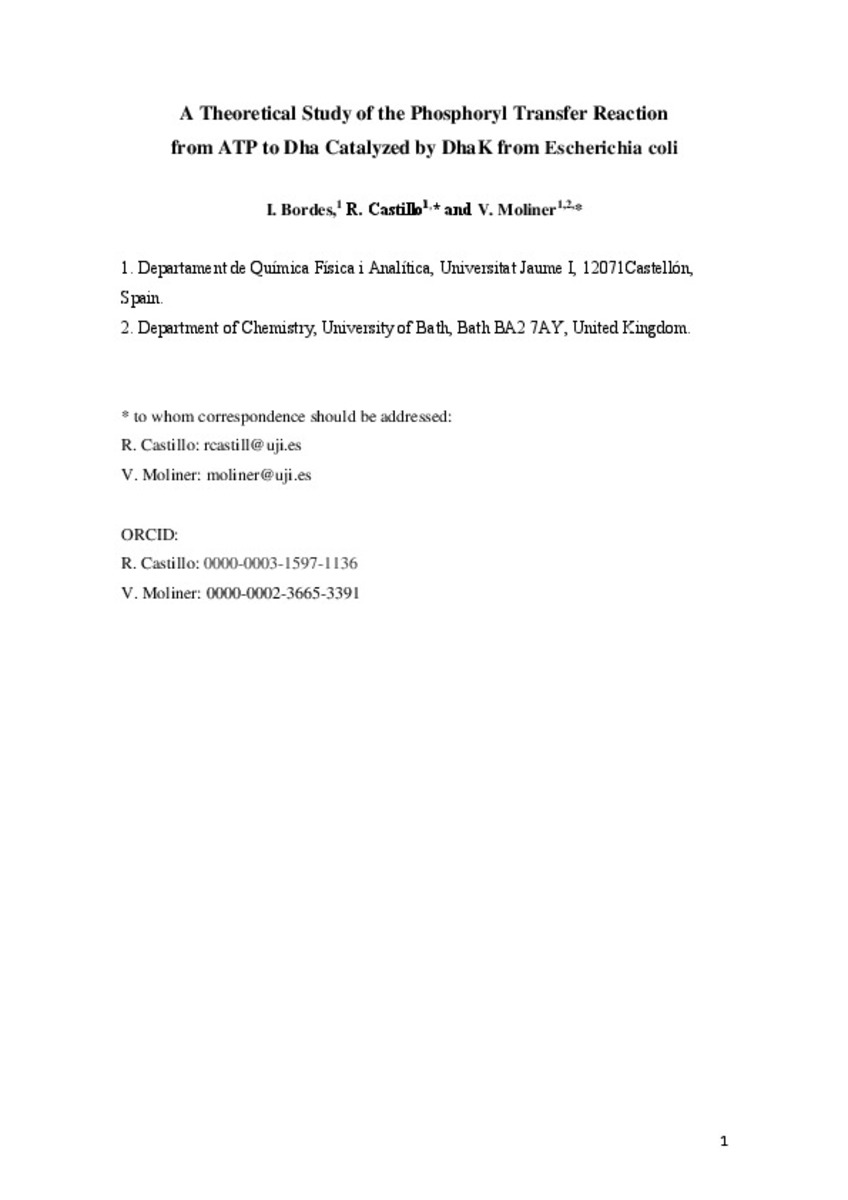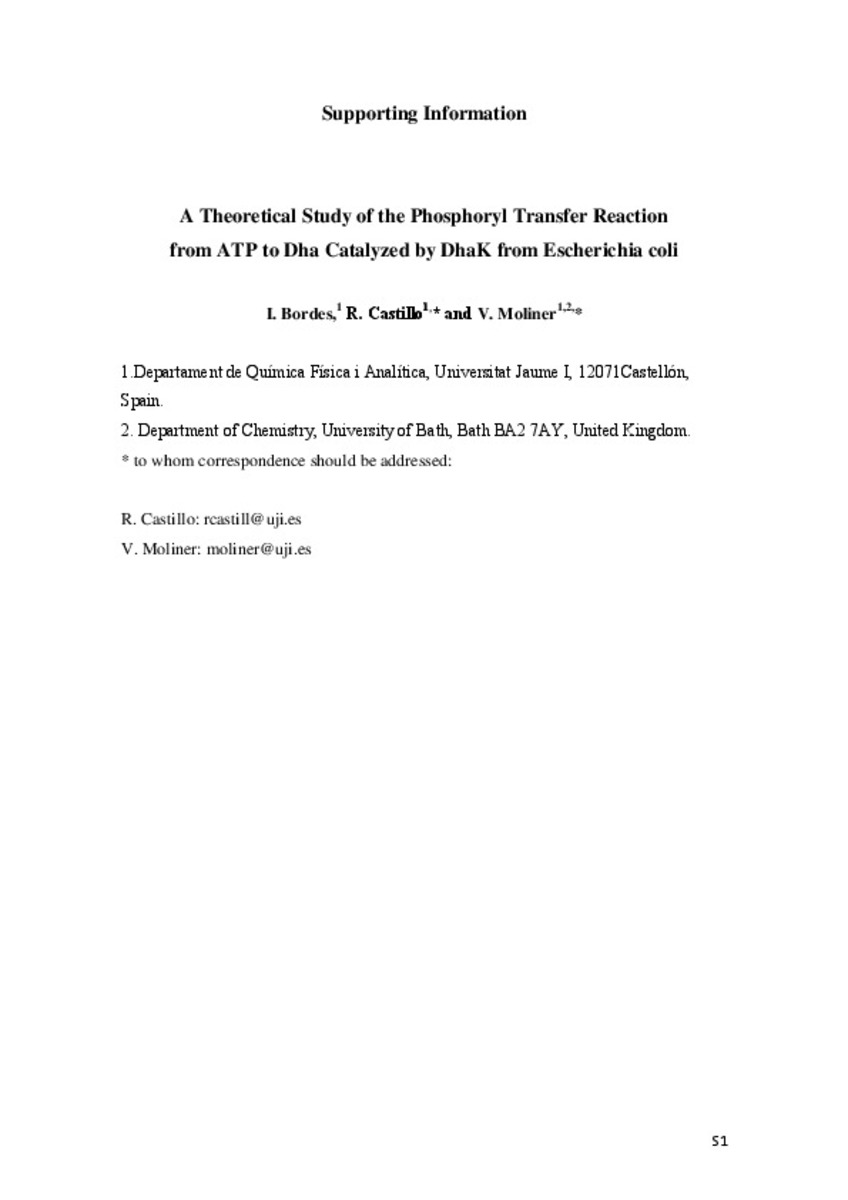Mostrar el registro sencillo del ítem
Theoretical Study of the Phosphoryl Transfer Reaction from ATP to Dha Catalyzed by DhaK from Escherichia coli
| dc.contributor.author | Bordes, Isabel | |
| dc.contributor.author | Castillo, Raquel | |
| dc.contributor.author | Moliner, Vicent | |
| dc.date.accessioned | 2017-11-17T10:24:08Z | |
| dc.date.available | 2017-11-17T10:24:08Z | |
| dc.date.issued | 2017-09 | |
| dc.identifier.citation | BORDES, Isabel; CASTILLO, Raquel; MOLINER, Vicent. Theoretical Study of the Phosphoryl Transfer Reaction from ATP to Dha Catalyzed by DhaK from Escherichia coli. The Journal of Physical Chemistry B, 2017, vol. 121, no 38, p. 8878-8892. | ca_CA |
| dc.identifier.uri | http://hdl.handle.net/10234/170174 | |
| dc.description.abstract | Protein kinases, representing one of the largest protein families involved in almost all aspects of cell life, have become one of the most important targets for the development of new drugs to be used in, for instance, cancer treatments. In this article an exhaustive theoretical study of the phosphoryl transfer reaction from adenosine triphosphate (ATP) to dihydroxyacetone (Dha) catalyzed by DhaK from Escherichia coli (E. coli) is reported. Two different mechanisms, previously proposed for the phosphoryl transfer from ATP to the hydroxyl side chain of specific serine, threonine, or tyrosine residues, have been explored based on the generation of free energy surfaces (FES) computed with hybrid QM/MM potentials. The results suggest that the substrate-assisted phosphoryl and proton-transfer mechanism is kinetically more favorable than the mechanism where an aspartate would be activating the Dha. Although the details of the mechanisms appear to be dramatically dependent on the level of theory employed in the calculations (PM3/MM, B3LYP:PM3/MM, or B3LYP/MM), the transition states (TSs) for the phosphoryl transfer step appear to be described as a concerted step with different degrees of synchronicity in the breaking and forming bonds process in both explored mechanisms. Residues of the active site belonging to different subunits of the protein, such as Gly78B, Thr79A, Ser80A, Arg178B, and one Mg2+ cation, would be stabilizing the transferred phosphate in the TS. Asp109A would have a structural role by posing the Dha and other residues of the active site in the proper orientation. The information derived from our calculations not only reveals the role of the enzyme and the particular residues of its active site, but it can assist in the rational design of new more specific inhibitors. | ca_CA |
| dc.format.extent | 14 p. | ca_CA |
| dc.format.mimetype | application/pdf | ca_CA |
| dc.language.iso | eng | ca_CA |
| dc.publisher | American Chemical Society | ca_CA |
| dc.rights | © 2017 American Chemical Society. | ca_CA |
| dc.rights.uri | http://rightsstatements.org/vocab/InC/1.0/ | * |
| dc.subject | Adenosinetriphosphate | ca_CA |
| dc.subject | Amino acids | ca_CA |
| dc.subject | Catalysis | ca_CA |
| dc.subject | Enzymes | ca_CA |
| dc.subject | Escherichia coli | ca_CA |
| dc.subject | Free energy | ca_CA |
| dc.title | Theoretical Study of the Phosphoryl Transfer Reaction from ATP to Dha Catalyzed by DhaK from Escherichia coli | ca_CA |
| dc.type | info:eu-repo/semantics/article | ca_CA |
| dc.identifier.doi | http://dx.doi.org/10.1021/acs.jpcb.7b04862 | |
| dc.relation.projectID | Spanish Ministerio de Economía y Competitividad (project CTQ2015-66223-C2), Universitat Jaume I (project P1•1B2014-26), Generalitat Valenciana (PROMETEOII/2014/022) | ca_CA |
| dc.rights.accessRights | info:eu-repo/semantics/openAccess | ca_CA |
| dc.relation.publisherVersion | http://pubs.acs.org/doi/abs/10.1021/acs.jpcb.7b04862 | ca_CA |
| dc.type.version | info:eu-repo/semantics/submittedVersion | ca_CA |
Ficheros en el ítem
Este ítem aparece en la(s) siguiente(s) colección(ones)
-
QFA_Articles [813]
Articles de publicacions periòdiques








